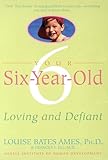 What this book is about
What this book is about
The six-year-old is just as complex as other ages as the child goes through stages of equilibrium and disequilibrium every six months. This is a guide of what happens with most children during their sixth year helps parents have patience and not feel out of control and when their children are acting in a manner they don’t understand. This book breaks it down into six month phases and breaks it down into chapters of the different areas of a child’s life. I know I did a blanket review of these books from age 1-14 but I just had to give this one its own review.
Punishment
Punishment just doesn’t work and usually isn’t fair anyway so they don’t advocate it. I believe in natural consequences helping to teach children but that also requires the child to be able to project forward and see what will happen if they do a certain thing. At this age it doesn’t work because they don’t learn to consider consequences until they are older so that one’s right out the window for me. Coping works much better.
Coping
There are several suggestions for how to help a distressed child and they move down the ladder from praise to giving in. Now I’m not one for praising anyone for doing something "right" or praising them without merit as John Taylor Gatto warns us against in Dumbing Us Down: The Hidden Curriculum of Compulsory Schooling so what this means to me is pointing out something that isn’t based on what I want her to do. What that means is that I may say that her room looks clean or something else like thanking her for helping me this morning when I was looking for my shoes. Just something that doesn’t remove or negate her internal barometer for self-approval. Giving in is the end of the line and is only used sparingly and then only if it’s something that isn’t important and I can just let it go. Another book, How to Talk So Kids Will Listen & Listen So Kids Will Talk is great for helping you and your child get along and get things done. Another option, which was referred to me and I’ll be reading, is Playful Parenting. It sounds like a very successful way to raise children and have fun at the same time. I would imagine it’s also easier to get their cooperation and participation.
Rudolf Steiner was right
In looking at it from the perspective of Waldorf education that Rudolf Steiner developed I can understand why he developed the curriculum to be based on the phase the child is going through at any particular age. Most of them go through the same things right around the same age.
7 year birthing
Steiner also felt that human beings have a birth every seven years. The first is the physical birth from the mother’s body when they emerge into the physical world in their new physical body. At this time they are still in the sheath of the mother’s energy field which lasts until age seven. So, we can see that, at age six, they are preparing to separate from the protective energy field of the mother. No wonder mother is the object of so much love and defiance during this age.
Mother
With the child getting ready to embark on their way without the energy field of the mother it stands to reason they would at times swing back and forth between self-assuredness and uncertainty. They are almost ready to stand on their own, energetically speaking, and they want to but they still feel the pull to hold onto their mother for as long as they can. It’s no wonder my six-year-old was so distressed when I was away from her for a week. She wants to hold onto that closeness of the energetic bond as long as she can.
Your guidance
Remember to always use your own internal guidance system as far as what’s the right thing to do at any time and also remember that, while there are similarities, not all children go through everything at the same time and some of them don’t go through everything mentioned in the book.
What you can skip/skim over
Proceed with caution through the section with stories from real life. They are in the format of someone writing into an advice column and the authors answering. Considering what we now know about the law of attraction I would recommend reading only the stories that are related to issues you are having with your child. (I stopped reading them about half-way through when I noticed I was starting to worry that my child might go through some of these issues and I didn’t want them to manifest so I stopped giving them my attention.)
What I didn’t like/would change about this book
1) In one of the stories where a girl was feeling particularly attached to a boy playmate, the author advises that, if the girl feels compelled to call the boy she should be told that, in our culture, girls don’t call boys. This is just not so in today’s world. Oh, that reminds me, in one other story (not in the same section) the daughter is asking the mother how she would find a husband and when the daughter says something like, "Then I’ll ask him to marry me," the mother tells her, "no," and says that the boy would ask her. I disagree and feel that a woman can ask a man to marry her. That’s what I think. 2) Watching television is offered as one possibility for 6 year olds at birthday parties. There has been much evidence to show that watching television isn’t in the best developmental interest of children of this age.
My experience
I got this book from the library but didn’t start to read it right away. In the meantime I was expressing my frustration to my husband about our daughter and how, no matter what, I just couldn’t win. He just said, "You know how you’re always telling me, ‘just read the book’? Well, I have to tell you the same. It’s all in there. You’re not going through anything unusual." So I read it and things got better right away. I’m also always amazed by how much more patience I have when I’ve been meditating and keeping refined foods out of my diet.
Additional things I got from it
Protect her from over-demand and over-stimulation to avoid her becoming distressed. Ignore table manners as much as possible. When helping to pick out clothes help her by offering two choices, even if she comes up with a third that she wants to wear. Let her wear the third. Have a longer chatting session before bedtime since that’s when they feel most comfortable processing the day.
Conclusions
This is such an essential book and, once again, saved me from "tearing my hair out". Even if you aren’t having trouble with your six-year-old this book can help you maximize the advantages of being 6.
View book details at Amazon: Your Six Year Old: Loving and Defiant
